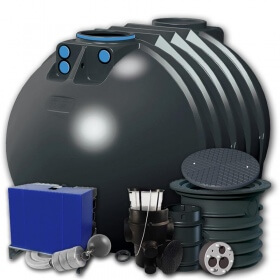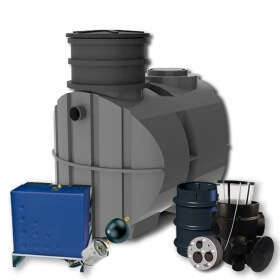- today
- label RAIN WATER MANAGEMENT
- favorite 8 likes
- remove_red_eye 68766 views
- comment 4 comments

LEGAL ASPECTS RELATING TO RAINWATER MANAGEMENT
Deficiencies in Polish law regarding clear regulations related to rainwater management lead to freedom in interpretation of the regulations.
System Location
The legal basis is the Regulation of the Minister of Infrastructure of April 12, 2002 on the technical conditions to be met by buildings and their location, as amended and amended.
Permits and declarations
In construction practice, due to the low interference in the environment of rainwater collection systems for watering gardens, there is no need to notify such a construction before starting the installation of the tank. An important issue that needs to be taken into account are the standards should be met when discharging sewage or water into the ground, specified in the Regulation of the Minister of the Environment of 24 July 2006 on the conditions to be met when discharging sewage into water or soil, and on substances particularly harmful to the aquatic environment. This act specifies the parameters that must be met when the excess rainwater is drained into the ground after the rainwater tank is completely filled. According to them, the water must not contain more than 100 mg / l of total suspended solids and a maximum of 15 mg / l of petroleum hydrocarbons (i.e. in the case of water drainage from the parking lot, we must first install an oil separator to pre-treat the drained water). Rainwater collected from roofs or terraces is not exposed to this type of pollution, therefore it is not necessary to use oil separators. In the case of using rainwater in home systems (flushing the toilet, watering the gardens, technical use of rainwater, etc.), it is not obligatory to submit a construction application to the Poviat Starosty along with a complete set of documents identical to the application for the construction of a home sewage treatment plant. Additionally, installations can be reported to the water utility in order to apply for metering of such an installation. This will allow for the reduction of costs related to the discharge of rainwater to a rainwater or combined sewage system. In this case, the water meter is installed between the inflow from the rainwater tank to the rainwater distribution center distributing the water in the building and at the outlet for watering the garden. In this way, it is possible to determine the amount of wastewater that is not discharged into the sanitary sewage system, but used for water supply in the building or watering the garden. Rainwater can be used to flush toilets, keep the apartment clean or used for laundry, which saves up to 50% of tap water. Of course, the issue related to the notification to the waterworks does not apply if the plot is equipped with a septic tank or a household sewage treatment plant.
System capacity selection
Due to the lack of standards and regulations related to the dimensioning or design of the capacity of the systems, it was assumed that the selection is made on the basis of the amount of rainfall at the investment site, as well as the roof surface and the material from which the roof is made. Based on these parameters, the amount of water that can be obtained is determined. It is also necessary to estimate the demand for rainwater depending on the purpose for which the water is to be used. It may depend on the area of the garden, the area of the apartment or the number of rainwater supply points.
Other legal aspects
- The basis for managing water resources is the Water Law of 18 July 2001. This legal act contains a provision stating that "the use of water may not deteriorate the ecological status of waters and ecosystems dependent on them" and gives the land owner the right to use from waters constituting its property, which also applies to groundwater in the area.
- The ordinance of the Minister of Infrastructure of April 12, 2002 on the technical conditions to be met by buildings and their location says that "a construction plot on which buildings are situated should be equipped with a sewage system that allows rainwater to be drained into the rainwater drainage system. or combined. If it is not possible to connect to a rainwater or combined sewage system, it is allowed to discharge rainwater to the own unpaved area, to absorption pits or to storage reservoirs”. The provisions of this ordinance define the manner of rainwater management for dry well or retention reservoirs.
- Regulation of the Minister of the Environment of 24 July 2006 on the conditions to be met when discharging sewage into water or soil, and on substances particularly harmful to the aquatic environment. The provisions of the above-mentioned legal act apply, inter alia, to the design of emergency overflows of rainwater management systems.
- Construction of a rainwater management system should be treated similarly to home sewage treatment plants, where an important aspect is safe distances from other facilities, e.g. foundation of a tank 5 m from the building, 2 m from the plot border, etc.
- The remaining parts of the assembly guidelines can be found in the assembly instructions prepared by the manufacturers of these solutions. It is worth referring to them because they often explain the method of securing the system against, for example, installation in groundwater, heavy soil or other difficult conditions.
- The legal basis is the Regulation of the Minister of Infrastructure of April 12, 2002 on the technical conditions to be met by buildings and their location, as amended and amended.
Related products
Gama Rainjet garden system
- Rainwater tank with filter, pump, hose, garden box
- Auto pressure pump
- Volume from 1000l to 3500l
Garden set Standard with Ecoline II tank
- Rainwater set with automatic pump and filter and collection in the lid
- Reinforced construction of the Ecoline II rainwater storage tank
- Capacities from 1700l to 10000l
Home and garden set Standard Blueline II
- Rainwater management system for the home and garden
- Serves toilets, urinals, washing machines and garden outlets
- Capacities from 5200l to 10000l and Domestic C-plus control panels
Home and garden set Standard Ecoline II
- Aquamatic Domestic C Plus air handling unit
- Maxi filter - 350m2 roof
- Tank capacities from 3400 l to 10000 l
- Reinforced construction ECOLINE II PLUS
Comments (4)
-
Czy w praktyce, gdy korzysta się z programu Moja Woda, Wojewódzki Fundusz Ochrony Środowiska ma prawo od nas żądać pozwolenia/zgłoszenia ze Starostwa. Co prawda składa się do WFOŚ tylko oświadczenie, ale ze słyszenia wiem, że są ich zapytania o takie dokumenty do Starostwa
-
bzdury wypisujecie. W zakresie zbiorników na deszczówkę obowiązują przepisy jak dla przydomowych oczyszczalni. interpretacji zaczerpując informacji w wydziałach architektury w starostwach powiatowych
-
kolego przedtem deszczowka byla traktowana jak sciek, teraz sie to zmienilo.
-
Odległość 5m od budynku w przepisach jest określona jako odległość od pokrywy zbiornika na nieczystości do okien lub drzwi pomieszczeń przeznaczonych na pobyt ludzi (WT paragraf 36 pkt 2). Nie dotyczy to zbiorników na deszczówkę




